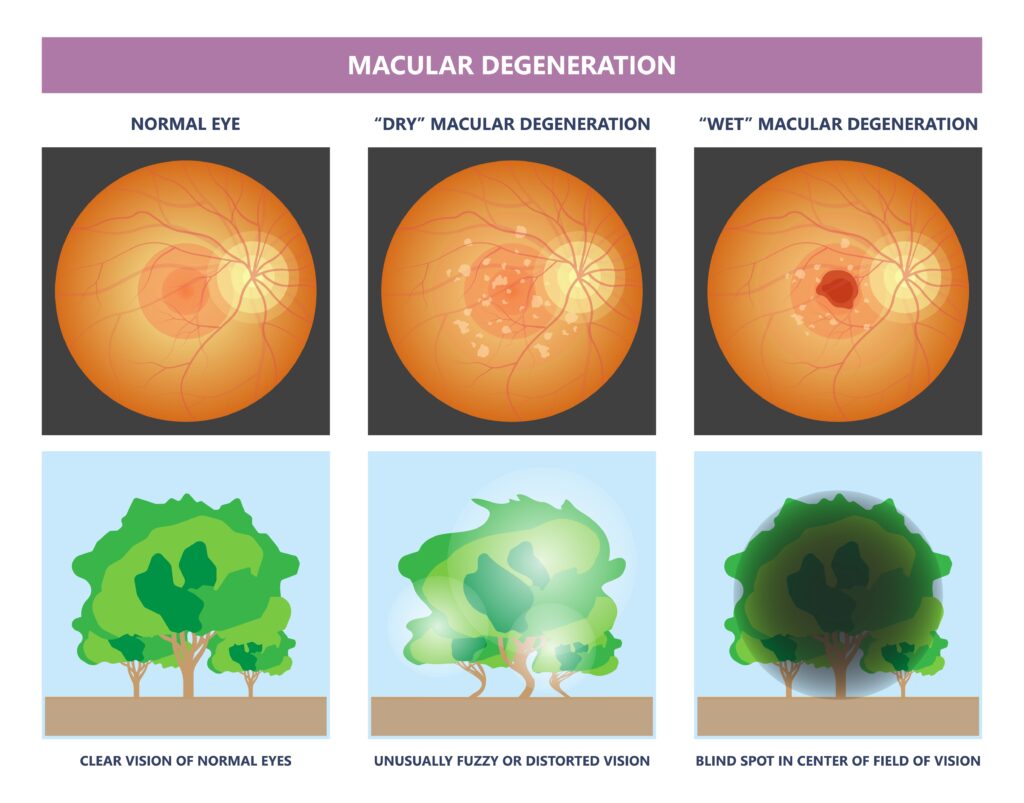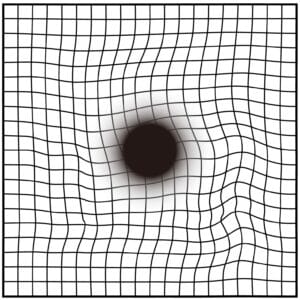What is AMD? Does AMD cause blindness?
Age-related macular degeneration (AMD) is a progressive eye disease that causes damage to the macula which is part of the retina at the back of the eye. The macula controls the sharp vision straight ahead of you, and damage to the macula affects a person’s central vision.
AMD is common amongst the elderly and is a leading cause of vision loss. While it does not cause complete blindness, those with AMD will find it difficult to read, drive or do simple things around the home.

What are the types of AMD and how are they different?
There two primary types of AMD – dry AMD and wet AMD.
Dry AMD is the most common form of AMD, accounting for 80% of AMD cases according to the American Academy of Ophthalmology. Dry AMD typically takes several years to progress and happens in three stages – early, intermediate and late stage. The late or advanced stage of dry AMD is also referred to as geographic atrophy (GA). In the advanced stage of AMD, the retina has atrophied and the macula has wasted away, leading to the loss of a person’s central vision.
Wet AMD, also referred to as exudative AMD, progresses quickly and occurs when abnormal blood vessels grow at the back of the eye causing macular damage.

What causes AMD? How does AMD develop?
One of the hallmarks of dry AMD is the accumulation of yellowish deposits known as drusen. Drusen is secreted by the retinal epithelium pigment (RPE) cells and can damage the integrity of the macula or back of the eye responsible for central vision. Most people over the age of 60 will have some levels of drusen deposits.
Hard drusen are small with well-defined borders and are associated with a lower risk of developing into AMD, whereas soft drusen are larger and cluster together and are associated with a higher risk of developing late-stage AMD, also known as geographic atrophy. Over time, soft drusen can lead to RPE detachments and damage the outer retina and cause central vision loss.

What are the risk factors leading to AMD and how many people are affected?
AMD is common among older adults. According to data collected by the U.S. Centers for Disease Control and Prevention, it was estimated that 19.8 million Americans aged 40 and older are living with AMD in 2019, about 12.6% of the population. An estimated 196 million people worldwide was estimated to have AMD.
As the name suggests, aging is a strong risk factor for developing AMD. Adults aged 50 or older, smoke, have a diet of high saturated fat, have cardiovascular disease or have a family history of AMD are more at risk of developing AMD. People of European ancestry are more likely to develop AMD than Blacks, Hispanics or Asians. In addition, people with blue eyes have higher incidence rates of AMD than someone with brown eyes.
Early detection is key to slow down the progression of AMD. A sign of whether you might have AMD is when straight lines look wavy.

What treatments are available for people with AMD?
Until recently, there were no approved pharmaceutical treatments for people with dry age-related macular degeneration, which accounts for about 80% of AMD cases. In 2023, the FDA approved two new treatments which are complement inhibitors for advanced stages of dry AMD (or geographic atrophy). These complement inhibitors are injected directly into the eye every one to two months.
In addition, there are surgical implants and ongoing clinical drug trials. An ophthalmologist may recommend specific vitamins to slow the progression of AMD in its intermediate stage. There is a large unmet medical need for patients with dry AMD which can lead to vision loss that impedes one’s ability to do their everyday activities.
In the last decade, anti-VEGF injection treatment was introduced, offering hope to patients with wet AMD and in many cases this treatment stabilized and saved their vision.

Age-related Macular Degeneration Resources
U.S. National Eye Institute: https://www.nei.nih.gov/learn-about-eye-health/eye-conditions-and-diseases/age-related-macular-degeneration
American Academy of Ophthalmology: https://www.aao.org/eye-health/diseases/amd-macular-degeneration
AMD Eye Test, Amsler Grid: https://www.hopkinsmedicine.org/health/conditions-and-diseases/agerelated-macular-degeneration-amd
U.S. Centers for Disease Control and Prevention: https://www.cdc.gov/visionhealth/vehss/estimates/amd-prevalence.html
AMD Library of Resources: https://www.nei.nih.gov/learn-about-eye-health/outreach-resources/outreach-materials?topic=246&type=All&audience=All&language=All
Statements contained in this article have not been evaluated by the U.S. Food and Drug Administration (FDA) and are not intended to diagnose, treat or cure any disease. The studies mentioned in this article have not been conducted under formal human clinical trials or reviewed by a regulatory agency. The results of the studies referenced in this article have not been proven to diagnose or treat any disease. Always check with your healthcare practitioner before starting any new treatment. Readers are cautioned that the research contained in the article is not exhaustive. InMed Pharmaceuticals Inc. undertakes no obligation to update the information contained in the article, except as required by law.








